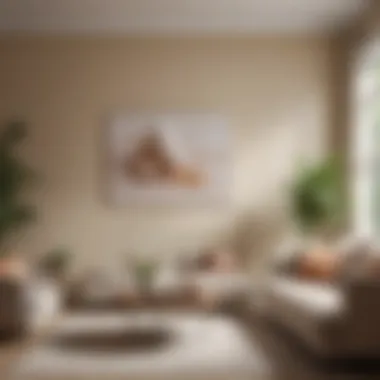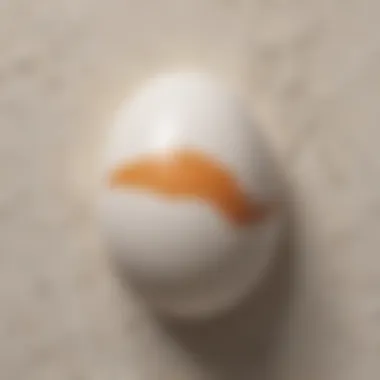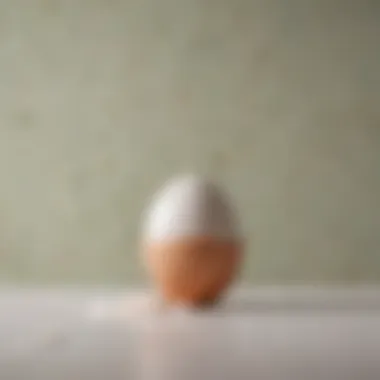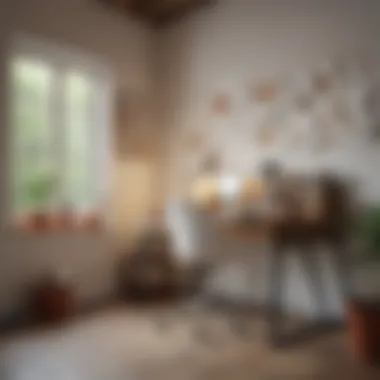Exploring Egg Shell Paint for Walls: A Comprehensive Guide


Intro
Egg shell paint is an often overlooked option for wall finishes. It presents a unique balance of durability and aesthetic appeal. The sheen of egg shell paint falls between flat and satin, making it popular among homeowners and interior designers alike. Understanding its characteristics and applications can help one make informed decisions about wall treatments. This guide is structured to explore the fundamental attributes of egg shell paint, providing insights into its uses, advantages, and practical tips.
As we move through the different sections, we will discuss the types of surfaces where egg shell paint shines. Additionally, we will explore various color palettes and application techniques. Our aim is to offer a comprehensive understanding, connecting the dots through practical advice and visual inspiration.
By the end, readers should feel equipped to enhance their spaces using egg shell paint, choosing finishes that both suit their style and meet their practical needs.
Understanding Egg Shell Paint
Egg shell paint has gained significant popularity in recent years due to its unique blend of aesthetic appeal and practicality. This section aims to illuminate what egg shell paint is, including its features and benefits, and how it stands apart from other wall finishes. Understanding its composition and characteristics can aid homeowners and design enthusiasts in making informed choices when selecting paint for their interiors.
Definition and Composition
Egg shell paint is a type of finish that presents a low sheen appearance, resembling the surface of an eggshell. This finish is typically achieved by mixing various resins with pigments, resulting in a smooth texture that reflects a small amount of light without being overly glossy. Egg shell paint usually contains a combination of acrylic or latex binders, making it water-based and relatively easy to work with.
Environmentally conscious consumers often prefer egg shell paint as many manufacturers produce low-VOC options. This characteristic means that the paint releases fewer volatile organic compounds during application and curing, thus contributing to better indoor air quality. Additionally, the formulation of egg shell paint includes high-quality pigments, which enhance color retention and durability over time.
Difference Between Egg Shell and Other Finishes
To effectively understand egg shell paint, it is essential to compare it with other common finishes like matte, satin, and gloss. The distinction lies not only in the sheen level but also in the application suitability and maintenance requirements.
Comparing Matte, Satin, and Gloss Finishes
Matte finishes are known for their non-reflective surface, providing a soft and subtle look. However, they can be challenging to clean and often show scuff marks easily. Conversely, gloss finishes have a shiny appearance, making them highly durable and easy to clean, but they may highlight imperfections on the wall surface. Egg shell finish lands in between these two options. Its slight sheen elevates the visual interest of the walls while remaining practical for everyday cleaning.
The unique feature of egg shell paint is the balance it strikes between appearance and functionality. Its seamless blend of durability and softness makes it a versatile choice for various settings, from living rooms to dining areas.
Durability and Cleanability
Durability and cleanability are critical factors when choosing wall finishes. Egg shell paint is notably resilient, offering a surface that withstands wear and tear. This resilience enhances its appeal to homeowners looking for long-lasting solutions.
The unique feature of egg shell paint in terms of cleanability is its ability to be wiped down without damaging the finish. The slight sheen helps resist stains and dirt accumulation, making it easier to maintain compared to flat paints. However, while it is more durable than matte finishes, it may not hold up as well in extremely high-traffic areas compared to satin or gloss options. This is an important consideration when deciding where to use egg shell paint.
"Choosing the right paint finish can dramatically impact the aesthetics and maintenance of your walls. Egg shell paint serves as an excellent compromise between durability and a sophisticated look."
In summary, understanding egg shell paint is about recognizing its balance of aesthetics, functionality, and environmental considerations. With this insight, you can make more educated choices tailored to your specific needs.
Properties of Egg Shell Paint
The properties of egg shell paint are crucial to understanding its usage in home decor. Egg shell paint sits between matte and satin finishes. It is characterized by a subtle sheen, which reflects light but does not create glare. This unique quality offers versatility, making it suitable for various rooms and applications.
Sheen Level
The sheen level of egg shell paint contributes significantly to its appeal. It has a soft, low gloss that provides depth without being overwhelming. This property allows it to hide surface imperfections better than higher sheen options. Consequently, it is often seen as an ideal compromise between aesthetics and practicality. Homeowners find that it suits both modern and traditional settings, adding a sophisticated yet understated look.
Texture and Appearance
Egg shell paint provides a smooth texture that enhances visual warmth in any space. It is popular because of its ability to create a welcoming atmosphere. Unlike flat finishes, egg shell offers a slight reflective quality. This characteristic can enhance the look of colors, making them appear richer and more vibrant. Additionally, the texture is gentle to touch, which adds to its appeal for indoor walls.
Environmental Considerations
Low-VOC Options


Low-VOC options are important when discussing egg shell paint. Volatile Organic Compounds (VOCs) are harmful chemicals that can contribute to air pollution. Choosing low-VOC paint helps to minimize health risks. The key characteristic of low-VOC options is that they emit fewer harmful fumes. This makes them a beneficial choice for family homes, especially with children or pets. Unique feature is their lower environmental impact. They often contain less harmful ingredients than traditional paints, making them more appealing for eco-conscious consumers.
Sustainability of Materials
Sustainability of materials is another critical aspect of egg shell paint. Homeowners are increasingly aware of their choices. Using paints that originate from renewable sources plays a significant role in reducing environmental footprints. The important characteristic is that sustainable materials often include natural resins and pigments. They are less harmful, providing peace of mind to users. However, the trade-off can sometimes be cost. Sustainable options might be more expensive than standard paints, but their long-term benefits can justify the investment.
"The choice of paint not only affects the aesthetic of your space but also plays a role in environmental sustainability and health issues."
Understanding these properties helps homeowners make informed decisions. As with any material, considering the application and the environment is key for achieving the best results.
Benefits of Using Egg Shell Paint for Walls
Understanding the benefits of egg shell paint is essential for anyone considering this option for their wall finishes. Egg shell paint offers a blend of aesthetic appeal and functional advantages that make it a preferred choice for homeowners and design enthusiasts alike. Its unique characteristics cater to diverse needs, whether it is the desire for a specific look or practical considerations like ease of maintenance and durability.
Versatility in Design
Egg shell paint provides versatility that is unmistakable. The subtle sheen complements various interior styles, from traditional to modern. This makes it suitable for nearly every room in a house. Furthermore, egg shell paint can adapt easily to different themes, helping to create cohesive spaces throughout a home. Its compatibility with a range of colors also contributes significantly to its design versatility.
The ability to choose colors that match furniture, decor, or even a specific mood adds to the charm of egg shell finishes. Homeowners can play with palettes without worrying about overwhelming the senses, making it ideal for both bedrooms and living areas.
Ease of Application
Egg shell paint offers an advantage in terms of application.
Compatibility with Various Surfaces
Egg shell paint is notably compatible with various surfaces. This characteristic makes it a beneficial option for many projects around the home. Whether painting drywall, plaster, or even wood, egg shell paint adheres well. This flexibility contributes to its popularity, as homeowners do not need to worry about primer or base coat on some surfaces.
Another strong point of this compatibility is the time it saves. Less prep work means faster application, allowing one to complete painting in shorter timeframes.
Tools Needed for Application
Using the correct tools is key for achieving a good finish with egg shell paint. Essential tools include brushes, rollers, and painter's tape. Each tool serves a specific purpose in achieving clean lines and smooth coatings. The use of high-quality brushes can enhance the application, impacting the final appearance positively.
Moreover, have tools readily accessible minimizes frustration during the process. This means that with the right tools on hand, one can quickly adapt to different application techniques according to the surface being painted.
Maintenance and Longevity
The maintenance of egg shell painted walls is relatively straightforward.
Cleaning Techniques
Cleaning techniques for egg shell paint involve basic methods that maintain its appearance without much hassle. A gentle soap solution and soft cloth often suffice for regular upkeep. This feature is particularly beneficial in high-traffic areas where fingerprints and marks appear more frequently.
The ease of cleaning makes it a practical choice for families with kids or pets where wall wear is more common. This durability increases the longevity of the finish, saving time and money in the long run.
Repairing Minor Imperfections
Repairing minor imperfections is another essential aspect of maintaining painted walls. Egg shell finishes can hide small dents or scratches effectively. If damage does occur, touch-up paint can often restore the area without needing to repaint the entire wall.
This quality is advantageous because it keeps the walls looking fresh and new. It also allows homeowners to manage wear and tear proactively, promoting a longer lifespan for the painted surfaces.
The benefits of egg shell paint combine aesthetic flexibility, ease of application, and low-maintenance care to create an appealing option for wall finishes.


Ideal Environments for Egg Shell Paint
Choosing the correct environment for egg shell paint applications is crucial for achieving the desired aesthetic and functional outcomes. The nature of this paint means it shines in certain areas while potentially underperforming in others. Understanding these environments will help homeowners and design enthusiasts make informed choices that enhance the longevity and visual appeal of their painted walls.
Suitable Rooms
Living Rooms and Dining Areas
Living rooms and dining areas are popular spaces for egg shell paint. This type of paint offers a subtle sheen that reflects light softly, creating a warm and inviting atmosphere. The delicate finish helps to accentuate the decor without overpowering it. In living rooms, where gatherings are common, egg shell paint stands as a great choice due to its balance of aesthetics and durability.
Moreover, egg shell finish is easier to clean compared to flat paint. This characteristic is beneficial when dealing with smudges or fingerprints from regular household activities. It ensures that surfaces look fresh longer, with minimal effort. However, homeowners should still consider using an appropriate cleaner to maintain the paint's integrity.
Bedrooms and Hallways
Egg shell paint is also ideal for bedrooms and hallways. The calming sheen contributes to a serene environment, promoting relaxation. In bedrooms, it can complement a peaceful design scheme while providing enough durability to stand up to everyday wear.
Hallways are often high traffic areas, and their walls can suffer from scuffs and marks. Egg shell paint's easy maintenance allows these spaces to stay looking their best. The key point about egg shell finish is that it brings a softness to walls, which adds to the comfort and style of both bedrooms and hallways, but careful selection of color is important to avoid overly bright or dark tones that can make these spaces feel cramped.
Avoiding Problematic Areas
High Moisture Rooms
High moisture rooms, like bathrooms or kitchens, present a challenge for egg shell paint. While it has better moisture resistance than some finishes, areas with constant humidity may compromise its durability. Its semi-gloss nature tends to work better in these spaces because it handles splashes and wipes down easily. Therefore, it's best to avoid using egg shell paint in areas where excessive moisture is an ongoing issue to prevent peeling and bubbling.
High-Traffic Areas
High-traffic areas, such as entryways and children’s playrooms, are also not ideal for egg shell paint. The finish can nick or scratch more easily in these locations, where wall surfaces endure regular abuse. While its cleanability is a plus, the durability of a glossier finish would typically serve these spaces better. This key factor is essential for maintaining a fresh appearance under constant use. Using a more resilient paint type in these areas will ultimately lead to a more satisfying outcome for the homeowner.
Choosing the Right Color
Choosing the right color is essential when considering egg shell paint for walls. Color impacts mood, space perception, and overall aesthetic. Selecting a color that works well with your environment can enhance the beauty of your home. Additionally, the right shade can create harmony with furniture and décor.
When deciding on a color, consider the purpose of the space. For a calming atmosphere in bedrooms, softer colors are often recommended. On the other hand, vibrant colors can stimulate conversation in living areas. It is also significant to think about how natural light affects different shades in various rooms throughout the day.
Understanding Color Psychology
Color psychology plays a vital role in how we perceive our surroundings. Different colors evoke distinct emotions. For example, blue is known for its calming effect, making it ideal for bedrooms. Yellow can bring a sense of warmth and energy, suitable for kitchens. By understanding these associations, homeowners can make informed choices that reflect their personality and the ambiance they want to create.
Trends in Wall Colors
When it comes to wall colors, trends can vary each year, influenced by social and cultural shifts. It's important to stay updated on popular shades to maintain a contemporary look in your home.
Popular Shades of Egg Shell Paint
Recent trends show that neutral tones like greys, beiges, and whites are highly favored for egg shell paint. These colors provide versatility and can adapt to various styles, from minimalist to more eclectic designs. The key characteristic of these shades is their ability to create a backdrop that enhances the features of the room without overpowering it.
Neutral egg shell colors are beneficial because they make spaces look larger and more open. However, overly relying on neutral tones can lead to a muted atmosphere, lacking energy and life. Thus, balanced combinations with accent colors are often suggested.
How to Select a Color Palette
Selecting a color palette should involve thoughtful consideration. A cohesive palette enhances visual appeal while allowing for creativity. One effective approach is to use the 60-30-10 rule, where 60% of the room is a dominant color, 30% is a secondary color, and 10% is an accent color. This method ensures a harmonious look without it becoming monotonous.
While choosing a palette, experiment with shades that resonate with your preferences. Homeowners may also take cues from existing furniture or artwork, integrating them into the color scheme. However, be cautious; an overwhelming mix of colors can create a chaotic environment. Aim for balance and clarity in your selections.


Application Techniques for Egg Shell Paint
Understanding the application techniques for egg shell paint is crucial. It ensures a smooth finish and maximizes the paint's durability and aesthetic appeal. Proper application techniques can help avoid issues like streaking or uneven color. This section focuses on how to properly prepare surfaces, select tools, and execute painting techniques effectively, thereby enhancing the overall result.
Preparing the Surface
Cleaning and Priming
Cleaning and priming are essential steps before applying egg shell paint. A clean surface allows for better paint adhesion and a more uniform application. The key characteristic of cleaning is the removal of dirt, dust, and grease. This helps in achieving a flawless finish. Priming further assists by creating a uniform surface that prevents paint from soaking into porous materials, leading to a more even color.
Benefits of cleaning and priming are significant. Proper preparation can enhance durability and reduce the likelihood of peeling or bubbling in the paint. Using a primer specifically designed for the surface type (drywall, wood, etc.) is also a popular choice as it helps in leveling imperfections. However, if not done adequately, these steps could lead to poor adhesion and compromised aesthetics.
Repairing Existing Damage
Repairing existing damage to the wall before applying egg shell paint is another vital step. This includes fixing cracks, holes, or blemishes. The main advantage of this step is its contribution to a seamless finish. If not addressed, damaged surfaces can show through the new paint, detracting from the overall appearance.
The unique feature of repairing damage is that it allows homeowners to refresh their space effectively. It is a beneficial choice because it can save on future repainting costs and maintain the integrity of the wall surface. However, improperly repaired surfaces might still show imperfections after painting, highlighting the importance of diligence in this preparation step.
Painting Process
Brush vs. Roller Application
The choice between brush and roller application can heavily impact the outcome of the egg shell paint job. Brushes are often used for detailed work, especially in corners or around trim. They are also particularly beneficial in tight spaces where rollers cannot reach effectively. Using a brush can help ensure a controlled application, leading to finer details and edges.
On the other hand, rollers cover larger areas more quickly. They provide a smooth finish on flat surfaces, rather than brush strokes. This tool is effective for larger walls and ceilings. The choice depends on the specific requirements of the project, though many find using both tools provides the best coverage.
Technique for Best Results
Employing the right techniques is paramount for optimal results with egg shell paint. Firstly, applying paint in thin coats rather than thick layers helps prevent drips and uneven textures. Thin layers allow for better drying and adhere more effectively.
Another recommended technique is to use a zigzag motion while applying with either a brush or a roller. This method ensures even coverage and helps to blend edges seamlessly. Adequately overlapping each stroke also aids in achieving an even coat. Lastly, allow each layer to dry completely before applying the next one.
By following these techniques, homeowners can enhance the longevity and aesthetic of their egg shell-painted walls, ensuring that they are both functional and pleasing to the eye.
Maintaining Egg Shell Painted Walls
Maintaining egg shell painted walls is crucial for preserving both the aesthetic appeal and functionality of the surfaces in your home. Unlike other finishes, egg shell paint strikes a balance between sheen and durability. It is often chosen for living areas where both style and cleanup are priorities. Regular maintenance ensures that the walls retain their finish and color longevity, which enhances the overall ambience of any room. Without proper maintenance, the walls can quickly lose their charm and require repaints more frequently.
Routine Cleaning Tips
To keep egg shell walls looking fresh, regular cleaning is essential. Dust and dirt can accumulate on surfaces over time, which dulls the sheen. Here are some effective cleaning tips:
- Use a Soft Cloth: Opt for a soft microfiber cloth to wipe down the walls gently. This method prevents scratching the surface.
- Mild Soap Solution: When deeper cleaning is necessary, a solution of warm water and a few drops of mild dish soap can effectively cleanse the paint without damaging it.
- Avoid Abrasives: Refrain from using harsh scrubs or strong chemicals, as these can wear off the protective layer over time.
- Spot Clean Stains: For stubborn stains, consider using a sponge with your soap solution. Rinse immediately to avoid residue.
Implementing these basic cleaning practices will maintain the integrity of your egg shell paint, ensuring that your walls continue to impress.
Repainting Considerations
When the time comes to repaint, several factors need consideration to ensure the new coat is applied correctly.
Color Fading and Wear
Color fading is a common occurrence with paint, especially if exposed to direct sunlight. The key characteristic of fading in egg shell paint is that it can lose vibrancy without showing significant signs of wear. This fading can contribute to an unwelcoming appearance of walls. It is particularly noticeable in rooms that receive a lot of light.
One beneficial aspect of color fading is that it may encourage homeowners to refresh their space, introducing new colors or styles. However, the unique feature of this wear is discernible in how it can complement the natural aging of your home’s decor by providing a subtle, lived-in feeling.
Preparing for a New Coat
Preparing for a new coat is a critical step in the repainting process. This involves cleaning the surface, filling in cracks, and sometimes priming for the new application. One key characteristic is assessing the condition of the current paint. A thorough inspection helps in deciding whether a full repaint or just touch-ups are necessary.
One downside to neglecting this preparatory phase is that it may lead to poor adhesion, causing the new coat to chip or peel prematurely. Conversely, taking the time to prepare properly will lead to a longevity of the new finish.















